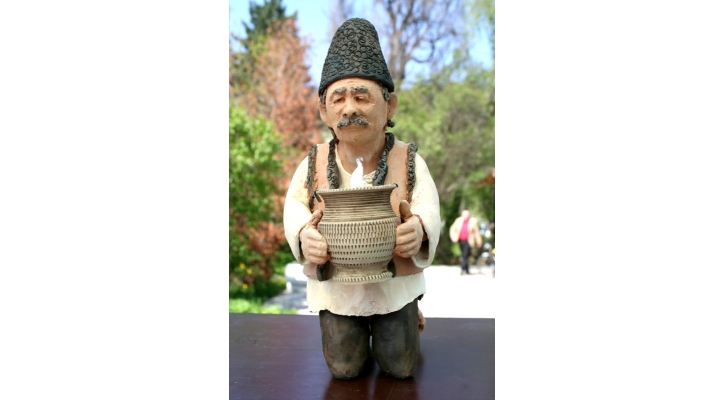A sculptor of traditional life
As I walked through the vine covered doorway to this artist’s workshop, I honestly did not expect to see such beautifully detailed figurines all around the room. Indeed, I had heard of his work but had not yet seen it for myself.

Nicolae Diaconu and his creations
This man proudly showed off his walls, all of which were lined with newspaper articles, certificates of appreciation and photographs of the places he has seen and the people he has met during his world-wide travels. His pottery pieces, ceramics and icons filled the room and brought such an overwhelming artistic feel to his workshop.
Who is this artist?
This friendly and talented man is Mr. Nicolae Diaconu.
Mr. Diaconu is a well-known ceramics artist who creates clay figurines representing traditional Romanian people and animals. Nicolae Diaconu grew up in the countryside of Tibanesti and is therefore familiar to rural people, their daily occupations and their working techniques. It is in his childhood memories that this special artist finds the inspiration for his most frequent creations. For example, he strives to represent a traditional Romanian man in his male figurines through their mimics, their faces, moustaches and longer hair.
His creations include figurines of men sitting on tree trunks reading, women tending to their sheep, young shepherds, sheep and cows. But this artist can also reproduce a person through a photograph of their portrait. Indeed he has created a figurine representing a Romanian ex-prime-minister, the well-known Romanian author Octavian Paler or just a man with an out-of-the-ordinary moustache. A reoccurring element in all of Mr. Diaconu’s characters is their traditional Romanian clothing which he proudly wears himself when participating in events in the country and even abroad. But this ceramic artist has a special secret; he only represents clothing on the figurines that he can reproduce himself. Indeed, he showed us a pair of traditional shoes called Opinci that he has made himself and that all of his characters wear on their feet to give all of them a rural touch.
Mr Diaconu, obviously passionate about his work, took us through to see some creations in the making. It was amazing to look at these beautiful figurines (not sculptures, as he kindly pointed out!) and feel what they would be expressing if they were living people. Indeed, the man sitting on a tree trunk looked lost in his thoughts and an elderly woman walking with a cane seemed upset and despaired. But on the other hand, the young children were full of joy and enthusiasm whilst proudly holding their shepherd’s crook. It must be a very hard task to make an expressionless piece of clay transmit a feeling and yet, Mr. Diaconu and his team have definitely accomplished the desired effect. When asked what a sculptor needs to have in order to create such figurines, the craftsman answered that: “It takes time and patience to create anything hand-made.”
He first began creating this type of figurines in 1979 in the town of Brasov, where he was studying the art of transforming modest clay into delightful ceramic pieces at the “Folk Art School”. He separated himself from the Neolithic form of ceramics used by other craftsmen and created his own style. For example, the figurines are not held on a base but stand freely on their own two feet, making them even more life-like. In doing so, he reactivated the folk art type, the technique of hand-working figurines that was slowly disappearing.
Mr. Diaconu is a member of the traditional art academy and is also the president of the group of artisans in this area. He also collaborates with many local shops, trading and selling items. He regularly speaks to the city hall about having arts and crafts exhibitions or special events involving craftsmen from the region.
Nicolae Diaconu and his team create a wide variety of objects including toys, magnets and toy soldiers. And as they have managed to capture true Romanian culture, they also make souvenirs for tourists that can be found in various shops around town. Mr Diaconu had a workshop in the etnography museum and plans to work with children with special needs once his new workshop is up and running. Needless to say this man is doing his best to help the local community through his amazing work.
When he travels to different countries, Mr. Diaconu presents his exhibition as “The universe of the Romanian village” and I think this title fits the characters perfectly for as my roommate Louise Solt, aged 21 said, “These figurines are images you would expect to see when thinking of Romania.” There is no doubt that this talented man has truly captured, not only the aspect of a Romanian village and the people in it, but also our hearts thanks to his creation of traditional rural life out of clay.
Text and photos: Brodie Robertson








